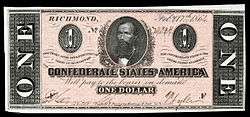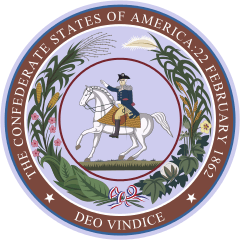Clement Claiborne Clay
| Clement Clay | |
|---|---|
 | |
| Confederate States Senator from Alabama | |
|
In office February 18, 1862 – February 17, 1864 | |
| Preceded by | Constituency established |
| Succeeded by | Richard Walker |
| United States Senator from Alabama | |
|
In office November 29, 1853 – January 21, 1861 | |
| Preceded by | Jeremiah Clemens |
| Succeeded by | Willard Warner |
| Personal details | |
| Born |
December 13, 1816 Huntsville, Alabama, US |
| Died |
January 3, 1882 (aged 65) Gurley, Alabama, US |
| Political party | Democratic |
| Spouse(s) | Virginia Tunstall |
| Alma mater |
University of Alabama, Tuscaloosa University of Virginia |
Clement Claiborne Clay (December 13, 1816 – January 3, 1882), also known as C. C. Clay, Jr., was a United States Senator (Democrat) from the state of Alabama from 1853 to 1861, and a Confederate States Senator from Alabama from 1862 to 1864. His portrait appeared on the Confederate one-dollar note (4th issue and later).
Biography
Early life
Clement Claiborne Clay was born to Clement Comer Clay and Susanna Claiborne Withers, a daughter of well-off planter John Withers, in Huntsville, Alabama.[1] He had a strong political pedigree; he was the oldest son of Clement Comer Clay, a U.S. senator and governor of Alabama. He was also a third cousin of Henry Clay, the noted statesman from Kentucky. Clay attended the Huntsville Green Academy, then studied at the University of Alabama at Tuscaloosa in 1833-1834. In August 1834, at the age seventeen, he received an A.B. degree. He served as his father's secretary in 1835-1837 after Clement Clay, Sr. was elected as a governor of Alabama. In 1837, he and his brother John Withers Clay both entered the University of Virginia; their brother Hugh Lawson Clay joined them later. In July 1839, Clay obtained a Bachelor of Laws degree after studying with John B. Minor, known for his rigor, and was admitted to the Alabama Bar on October 2, 1839.[2]
Marriage and family
On February 1, 1843 he married Virginia Tunstall, who was then 18 years old. They had one child, who died stillborn.[1]
After Clement's death in 1882, Virginia remarried to David Clopton, a judge, and was known as Virginia Clay-Clopton. Virginia wrote Belle of the Fifties, a memoir with New York journalist Ada Sterling, published in 1904 and re-issued in 1905. Belle was one of three memoirs by southern women particularly recommended by the United Daughters of the Confederacy to its membership for studying.[3] Her book became part of the discourse about the Lost Cause and the burnished memory of the antebellum South.
Career

In 1839-1846, C. C. Clay, Jr. practiced law in a family law firm; in 1846-1848 he served as Madison County judge. Clay was a member of the Alabama State House of Representatives in 1842, and in 1844-1845. He ran for the United States Congress in 1850, but did not succeed after losing to an incumbent.[2]
In 1853, he was elected by the Alabama legislature to serve in the United States Senate in a term beginning March 4, 1853; and was re-elected in 1857. Due to the legislature's delay in filling the position, he served from November 29, 1853 to January 21, 1861. In the Senate, he defended the state's rights during the political debates of the time, and opposed Henry Clay.[2] He withdrew from the Senate when Alabama seceded from the Union on January 11, 1861 before the American Civil War broke out. He was subsequently elected by the Alabama Confederate legislature as Senator in the First Confederate Congress. He served there from 1862 until 1864 acting as a supporter of Jefferson Davis.
Along with Jacob Thompson, Clay was a part of the Confederate War Department effort to create a network of secret agents to conduct espionage and sabotage.[4] In May 1864, president Davis sent Clay to Canada with a secret mission to coordinate activities of the Southern sympathizes in the Great Lakes area, including members of the Order of the Sons of Liberty and the Knights of the Golden Circle.[5] Clay took part in a secret meeting with John Hay, President Abraham Lincoln's aide, at Niagara Falls, Canada.[6]
It was suspected that Thompson and Clay had employed John Wilkes Booth for some services before he assassinated President Abraham Lincoln.[7] President Andrew Johnson signed an order to arrest Clay. After learning from a newspaper that a reward was issued for his capture, Clay, who initially planned to escape to Mexico, turned himself in to General James H. Wilson in Macon, Georgia in May 1865. He was arrested and held in Fort Monroe in Hampton, Virginia until April 1866.[4] Former Confederate president Jefferson Davis was also held in Fort Monroe, but was never tried; he was released in 1867.
Postwar years
Clay was imprisoned by the United States government under impression that he was involved in the plot to assassinate President Abraham Lincoln. Virginia Clay played some role in her husband's release as she went to Washington, D.C. and personally pleaded with the President Johnson.[1] The Clays returned to Alabama and struggled to rebuild their lives living on a farm. Clay tried to practice as an attorney and entered insurance business in Huntsville, however without much success due to a poor health, ultimately returning to his farm in January 1882. He died in 1882 in Madison County besieged by debts and health problems, and is interred at Maple Hill Cemetery.
Works
- Clay, C C, and William M. K. Gwin. Invasion of Harper's Ferry: Dangers and Duties of the South. Washington: Printed at the Congressional Globe Office, 1859.
- Speech of the Hon. C.c. Clay, Jr., of Alabama, on the Contest in Kansas, and the Plans and Purposes of Black Republicanism: Delivered in the United States Senate, April 21, 1856.
- Speech of C. Clay, Jr., of Alabama, on the Bill to Admit Kansas: Southern Rights, How Menaced by Northern Republicanism, Delivered in United States Senate, Mar. 19, 1858.
- Speech of Hon. C. C. Clay, Jr., on slavery issues. Delivered at Huntsville, Alabama, September 5th, 1859.
References
- 1 2 3 Bleser, Carol K. R. In Joy and in Sorrow: Women, Family, and Marriage in the Victorian South, 1830-1900. New York: Oxford University Press, 1991.
- 1 2 3 Nuermberger, Ruth K. The Clays of Alabama: A Planter-Lawyer-Politician Family. Lexington: University of Kentucky Press, 1958.
- ↑ Sarah E. Gardner, Blood And Irony: Southern White Women's Narratives of the Civil War, 1861-1937, University of North Carolina Press, 2006, pp. 128-130
- 1 2 Michael B. Chesson. Clay, Clement Claiborne. American National Biography Online, February 2000. Retrieved December 13, 2015.
- ↑ Intelligence in the Civil War. A publication of the Central Intelligence Agency. — Conspiracy in Canada, pp. 42-46.
- ↑ Confederacy’s Canadian Mission: Spies Across the Border, Historynet.com.
- ↑ Tidwell, William A. April '65: Confederate Covert Action in the American Civil War. Kent, Ohio: Kent State University Press, 1995
Further reading
- Clay-Clopton, Virginia. A Belle of the Fifties: Memoirs of Mrs. Clay, of Alabama, Covering Social and Political Life in Washington and the South, 1853-66, New York: Doubleday, Page & Company, 1905. (Full text available at Documenting the American South website, University of North Carolina.)
- Nuermberger, Ruth K. The Clays of Alabama: A Planter-Lawyer-Politician Family. Lexington: University of Kentucky Press, 1958.
- Thornton, J M. Politics and Power in a Slave Society: Alabama, 1800-1860. Baton Rouge: Louisiana State University Press, 1978.
- Tidwell, William A. April '65: Confederate Covert Action in the American Civil War. Kent, Ohio: Kent State University Press, 1995.
- Wiley, Bell Irvin. Confederate Women. New York: Greenwood Press, 1975.
External links
- United States Congress. "Clement Claiborne Clay (id: C000480)". Biographical Directory of the United States Congress.
- Short biography on Political Graveyard
- "Clement Claiborne Clay". Find a Grave. Retrieved 2009-04-06.
| United States Senate | ||
|---|---|---|
| Preceded by Jeremiah Clemens |
United States Senator (Class 2) from Alabama 1853–1861 Served alongside: Benjamin Fitzpatrick |
Succeeded by Willard Warner(1) |
| Confederate States Senate | ||
| New constituency | Confederate States Senator (Class 1) from Alabama 1862–1864 Served alongside: William Yancey, Robert Jemison |
Succeeded by Richard Walker |
| Notes and references | ||
| 1. Because of Alabama's secession, the Senate seat was vacant for seven years before Warner succeeded Clay. | ||

